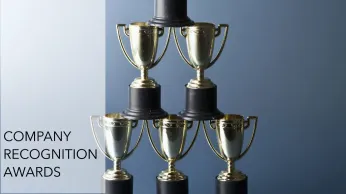Rewards and Recognition for the Rewarder: Why Star-Makers Deserve the Spotlight Too
Recognizing high performers is important—but so is appreciating those who uplift others. This blog explores why your rewards and recognition strategy should include recognition champions, and how to empower them to sustain a culture of appreciation.
Pada halaman ini
- The unsung heroes of your R&R programs
- Why your R&R strategy should include the rewarder
- Spotting rare talent is a rarer talent
- Traits that define star-makers in the workplace
- Making rewards and recognition more holistic
- It's time to say thank you to the recognizers
- Recognition for the rewarder: what it looks like in practice
- Help your rewards and recognition champions do their jobs better
- Closing the loop: the ROI of recognizing the recognizer
- Conclusion: it's time for a return gift
Norma Jeane Mortenson was just another worker in a U.S. military factory until a passing photographer noticed her and sent her picture to a magazine. That seemingly ordinary moment led to a modeling contract, and eventually, a Hollywood legacy. The world knows her today as Marilyn Monroe.
Such moments of serendipitous discovery aren’t just limited to Hollywood. Harrison Ford was spotted by George Lucas while fixing a door. Johnny Depp got his first break because he accompanied a friend to an audition. Quentin Tarantino’s belief in Samuel L. Jackson’s talent changed the course of cinema. In each case, the discoverers were just as important as the stars they helped reveal.
This idea applies just as much in the workplace. There are people in every organization who identify, encourage, and reward excellence. These are your star-makers—team leads, peers, and mentors—who ensure that great work doesn’t go unnoticed. It’s time to recognize them, too.
The unsung heroes of your R&R programs
Rewards and recognition (R&R) strategies have traditionally focused on top performers—those who exceed targets, innovate boldly, or go the extra mile. But what about the individuals who consistently spot and celebrate these efforts?
The colleague who shouts out a quiet contributor in a town hall. The manager who never misses a chance to give kudos. The HR champion who drives your R&R calendar with energy and empathy.
These people are the ones fueling a culture of appreciation. Without them, recognition would be just a policy, not a practice.
Why your R&R strategy should include the rewarder
While top performers often steal the spotlight, it’s the people who recognize and elevate them that keep the culture of appreciation alive. These individuals quietly shape team morale and engagement—and it’s time they got the credit they deserve.
Recognition shouldn't stop at those who deliver results. It should extend to those who enable those results by consistently acknowledging and celebrating the efforts of others.
1. They set the tone for culture
When someone consistently acknowledges good work, they create a ripple effect. Others are encouraged to recognize, engage, and build meaningful work relationships. These individuals become culture carriers—champions of positivity, performance, and psychological safety.
2. They drive performance from behind the scenes
These ‘recognition champions’ may not always be the ones on stage receiving the trophy, but they make sure the right people do. By reinforcing positive behavior, they amplify results across teams and departments.
3. They hold the recognition engine together
Your R&R programs can only succeed when someone owns and activates them. These are often the same people promoting peer-to-peer recognition, reminding managers to give kudos, or designing nomination workflows. They ensure your appreciation efforts don’t lose momentum.
Spotting rare talent is a rarer talent
While data, frameworks, and tools are essential to track performance, the art of discovering greatness is not purely scientific. Talent spotting requires intuition, empathy, and the courage to recognize value in places others may overlook.
Like identifying a panda in a room full of teddy bears, the ability to detect potential before it shines brightly is a skill honed through experience and driven by intent.
This intuitive muscle can belong to anyone—regardless of department, title, or tenure. It can come from a senior executive, a first-time team lead, or even a junior colleague who sees brilliance in someone else's silent commitment.
Traits that define star-makers in the workplace
These individuals may not always be in the spotlight, but they are the reason others get there. Their quiet contributions build the foundation for a thriving, recognition-rich culture. Ignoring their impact means overlooking the very people who make appreciation happen.
- Curious observers: They pay attention to the little things—small wins, incremental progress, behind-the-scenes effort.
- Genuine encouragers: They celebrate others without expecting anything in return.
- Culture catalysts: They believe in recognition not as a checklist item, but as a way of life.
- Fair validators: They ensure appreciation is distributed equitably, not just to the loudest voices in the room.
- Organizational glue: They connect people through shared wins and amplify the stories that matter.
These people are not just enablers of success; they’re multipliers of it.
Making rewards and recognition more holistic
Traditionally, rewards and recognition have centered around annual reviews, top-down awards, and milestone celebrations. While these efforts are valuable, they often fall short of building a culture where appreciation flows freely and frequently.
A truly effective R&R strategy must go beyond the occasional trophy or bonus. It needs to be embedded into the everyday rhythms of work and made accessible to everyone—not just top performers.
1. Recognition must be continuous, not episodic
Recognition should not be confined to quarterly meetings or year-end functions. A holistic approach ensures that appreciation becomes a daily habit, not a corporate obligation. Whether it's a quick “thank you” during a stand-up, a virtual high-five on a collaboration tool, or a thoughtful note shared on the intranet, small gestures of appreciation can have a lasting impact.
2. Appreciation must be inclusive and multidirectional
To build a recognition-rich culture, organizations must encourage appreciation across all levels—upward, downward, and peer-to-peer. Everyone, regardless of role or rank, should be both empowered to give recognition and feel safe to receive it. This fosters inclusivity and makes recognition feel authentic rather than performative.
3. Technology can enable consistency and scale
To make recognition scalable and sustainable, it needs to be easy to implement and accessible from anywhere. That’s where a platform like Empuls comes in. Empuls empowers organizations to automate, personalize, and democratize recognition—making it simple for every employee to give and receive appreciation in the flow of work.

Dengan Empuls , syarikat boleh:
- Set up peer-to-peer, spot, and milestone awards with ease
- Integrate recognition into collaboration tools like Slack, MS Teams, and more
- Use smart nudges and AI-powered insights to prompt meaningful recognition
- Celebrate wins with a global rewards catalog that caters to diverse preferences
- Track program effectiveness through detailed analytics and feedback loops
In short, Empuls helps organizations transform recognition from a one-time gesture into a company-wide habit—ensuring that appreciation becomes part of the culture, not just a checkbox.
A holistic approach to R&R doesn't just reward output. It nurtures relationships, builds trust, and aligns teams around shared values. When recognition becomes part of how people work together every day, it becomes one of your strongest tools for engagement and performance.
It's time to say thank you to the recognizers
When you thank the people who make appreciation possible, you’re reinforcing the behaviors that keep your culture alive.
Here’s how to make that recognition real and impactful:
1. Create a dedicated reward category for recognizers
Launch a “Top Recognizer of the Month” award or a “Culture Champion” badge to highlight individuals who actively drive appreciation across the company.
2. Share their stories
Feature them in internal newsletters, intranet shoutouts, and leadership emails. Let the entire organization see the power of acknowledgment in action.
3. Integrate them into your R&R framework
Ensure that your rewards and recognition platform tracks who initiates recognition—not just who receives it. This data can help you identify your star-makers.
4. Celebrate their milestones
Just like you’d celebrate sales goals or project completions, make it a point to recognize the consistency and care with which they encourage others.
5. Provide them with tools and autonomy
Empower these individuals with access to recognition budgets, nomination tools, and leadership support so they can amplify good work quickly and efficiently.
Recognition for the rewarder: what it looks like in practice
Recognizing those who consistently celebrate others sends a powerful message—it shows that appreciation is a valued behavior, not just a managerial responsibility. When you spotlight the rewarders, you create more of them, fueling a culture where recognition becomes second nature.
1. Recognize the recognizers
Give shoutouts or awards to those who nominate others for accolades. Consider creating a “best nomination” award that highlights meaningful recognition write-ups.
2. Celebrate their consistency
Track recognition activity (e.g., how often someone sends kudos or participates in peer nominations) and reward consistent contributors to the culture.
3. Let them lead recognition rituals
Involve these individuals in town halls, R&R ceremonies, or team meetings. Let them host, announce, or present recognition to make them feel included and empowered.
4. Personalize their rewards
Give them a choice of curated rewards from your global catalog—whether it’s learning opportunities, experiences, or team-based celebrations.
Help your rewards and recognition champions do their jobs better
Recognition champions—those who consistently acknowledge and uplift others—play a pivotal role in shaping an engaged, high-performing culture.
But even the most well-intentioned champions need the right tools, support, and systems to keep the momentum going. It’s not just about saying “thank you”—it’s about making recognition efficient, inclusive, and sustainable across the organization.
1. Equip them with the right tools
Give your champions access to a platform that simplifies recognition. Solutions like Empuls make it easy to give kudos, automate rewards, and track recognition activity—all from one centralized place.

With features like AI-powered nudges, ready-to-use templates, and seamless integrations with Slack, MS Teams, and email, Empuls empowers everyone to recognize in the flow of work.
2. Provide autonomy and authority
Recognition shouldn’t be bottlenecked. Allow your champions—whether they’re team leads, HR partners, or peers—to own parts of the recognition process. Give them access to nomination tools, spot budgets, and approval rights so they can recognize great work in real time without waiting on a complex approval chain.
3. Offer ongoing training and support
Even seasoned managers may need guidance on giving meaningful recognition. Offer short training sessions, playbooks, or webinars that share best practices on giving timely, authentic, and impactful praise. Empuls, for example, includes in-product tips and nudges that help users craft thoughtful messages aligned with company values.

5. Celebrate their efforts too
Recognition champions often operate behind the scenes. Make sure their contributions are visible and appreciated. Highlight their stories in internal communications, give them a platform in team meetings, or create a special award category just for them.
6. Streamline the process
Reduce friction in the recognition workflow. Ensure recognizers don’t have to jump through hoops to appreciate someone. Empuls allows quick recognition in a few clicks—whether it’s a birthday wish, a value badge, or a nomination for a quarterly award—ensuring the experience is smooth and rewarding for the giver as well.

By enabling your recognition champions with the right mix of tools, trust, and visibility, you’re not only helping them succeed—you’re reinforcing a culture where appreciation is proactive, not reactive. Give them the support they need, and they’ll help your recognition strategy thrive.
Closing the loop: the ROI of recognizing the recognizer
While most organizations measure the impact of rewards and recognition by looking at engagement scores, retention rates, or productivity metrics, there’s a lesser-known but equally powerful lever to maximize that ROI—recognizing the recognizers themselves.
These are the people who keep your culture alive. They are the silent drivers of motivation, the ones who consistently amplify the good in others, and the connectors who make sure that no achievement goes unnoticed. By celebrating their efforts, you’re reinforcing the very behaviors that your organization wants to scale.
Why this matters for business outcomes
When recognition champions feel seen and appreciated for their role, they become even more committed to nurturing a culture of appreciation. They continue to model positive behavior, encourage peer-to-peer recognition, and set an example for others to follow. This creates a ripple effect—one that expands far beyond the individual being recognized.
Moreover, recognition champions often bridge the gap between employees and leadership. Their continued efforts build trust, increase transparency, and ensure that recognition is not just a function but a mindset embedded across the organization.
Tangible benefits of closing the recognition loop
These benefits go beyond feel-good moments—they shape how people show up, collaborate, and commit to their roles. When recognizers feel valued, they become long-term culture carriers who inspire others to participate, creating a workplace where appreciation is both shared and sustained.
- Increased participation in R&R programs: When recognizers are acknowledged, others are inspired to join in—leading to higher adoption across teams.
- Greater cultural alignment: Recognizers often tie appreciation to company values, helping reinforce what behaviors matter most.
- Higher employee engagement: Recognition becomes more frequent and widespread, boosting morale and satisfaction across departments.
- Sustainable appreciation habits: Acknowledging the recognizer helps institutionalize recognition as an everyday practice, not just an HR initiative.
In essence, recognizing the recognizer completes the loop. It turns appreciation into a continuous, self-sustaining cycle—one where everyone feels empowered to give, receive, and celebrate excellence. It’s not just good for culture; it’s a smart business strategy with measurable returns.
When you invest in those who keep your culture thriving, you're not just closing a loop—you’re creating a flywheel for long-term engagement and performance.
Conclusion: it's time for a return gift
Recognition shouldn’t be the responsibility of HR alone. It should be everyone's responsibility—and everyone's reward.
As your company grows, the impact of small acts of appreciation becomes even more meaningful. It’s time to evolve your rewards and recognition strategy to include the silent champions—the ones who make it all happen.
So the next time someone gives a heartfelt thank you, puts forward a thoughtful nomination, or claps the loudest at a colleague’s win, remember: they’re a star too.
Let’s make sure they feel like one.
Empuls makes it easy to track, manage, and celebrate recognition across your organization.
Explore Empuls and build a culture where everyone feels valued—especially those who value others.













